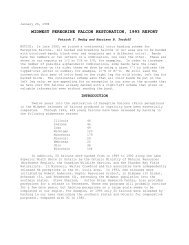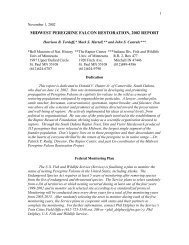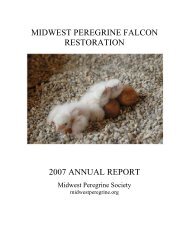2006 - Midwest Peregrine Falcon Restoration Project
2006 - Midwest Peregrine Falcon Restoration Project
2006 - Midwest Peregrine Falcon Restoration Project
You also want an ePaper? Increase the reach of your titles
YUMPU automatically turns print PDFs into web optimized ePapers that Google loves.
10<br />
hatched and fledged, one female and two males. First year nesting attempted: 2005; total young<br />
produced: 7.<br />
20. SP-Blatnik Bridge, Duluth, St. Louis County, Minnesota / Superior, Douglas County,<br />
Wisconsin. Dave Evans reports that an unbanded adult male was paired with a new female, black<br />
*B/8, fledged in 2004 from Mount McRae, Ontario. The pair fledged 3 young, unbanded due to<br />
traffic safety considerations. First year nesting attempted: 1995; total young produced: 6.<br />
21. SP-Greysolon Plaza (aka Duluth Hotel), Duluth, St. Louis County, Minnesota. Rob<br />
MacIntyre and Amy Ries scored a home run when they captured the unbanded adult female here,<br />
who is now known as Amy b/g 82/C; the male is still unbanded. They laid four eggs, hatched and<br />
fledged four young, two of each sex. First year nesting attempted: 2003; total young produced: 10.<br />
22. SP-Bong Bridge, Superior, Douglas County, Wisconsin / Duluth, St. Louis County,<br />
Minnesota. Dave Evans reported that that eleven-year-old male Trevor b/r K/*A, fledged in 1995<br />
from a cliff at Kennedy Creek, Minnesota was paired with three-year-old female black *Y/6, fledged<br />
in 2003 from Caribou Island, Ontario. This pair nested in a new location closer to land on the<br />
Minnesota section of land, on a beam of the bridge. Two young males were banded when they were<br />
found to have landed below the bridge at about 30-35 days of age. The pair was believed to have<br />
failed, but had actually just moved locations from the usual tub located in the center of the bridge<br />
over water to the new location. One of the young was found dead on the bridge July 9th by Dave<br />
Evans. First year nesting attempted: 1994; Total young produced: 8.<br />
Each year, Minnesota North Shore peregrines are banded with the essential and much<br />
appreciated help of expert climbers from the Wolf Ridge Environmental Learning Center,<br />
Finland, Minnesota. This year the climbers and others that helped at North Shore sites were<br />
(alphabetically): John Arent, Gail Buhl, Dave Evans, Dave Graf, Brice Hansen, Peter Harris,<br />
Brad Johnson, Jim Mussell, Peter Smerud, Joel Sneiwolski, Mike Steffes, Joe Walewski, and<br />
Lori Walewski.<br />
23. SP-Superior Shores, Rocky Point, Two Harbors, Lake County, Minnesota. New Site.<br />
Dave Evans reported nesting activity at this site. An adult unbanded male was present with threeyear-old<br />
female Phoenix b/g 96/E, fledged in 2003 from North Shore Mining, Silver Bay,<br />
Minnesota. The pair failed in late May, but was observed to have re-nested in an old raven nest<br />
by June 11 with three eggs. On July 31, Adam Barnett climbed to the nest; two female chicks<br />
were safely banded and fledged from the site in late August. First year nesting attempted: <strong>2006</strong>;<br />
total young produced: 2.<br />
24. SP-Crow Creek, Lake County, Minnesota. This site was occupied regularly by the<br />
pre-DDT peregrines and now since 2003. Six-year-old Wally b/g P/R, fledged at Palisade Head<br />
in 2000, paired with an unbanded female. Two young females were banded on June 8, and<br />
fledged successfully by the end of the month. Dave Evans identified male Wally b/g P/R in 2002<br />
at Silver Cliff, about two miles from Crow Creek. First year nesting attempted: 2003; total young<br />
produced: 6.<br />
25. SP-Castle Cliff, Castle Danger, Lake County, Minnesota. Mike Steffes and Dave<br />
Evans reported on this pair for the fifth season. As in previous years, the female was unbanded.<br />
The male was banded b/g, but remained too secretive to further identify him. Four eggs were<br />
laid, four hatched, and four young were banded, three females and one male. The three young<br />
females were found to have died or were missing from the eyrie before fledging age, leaving a








